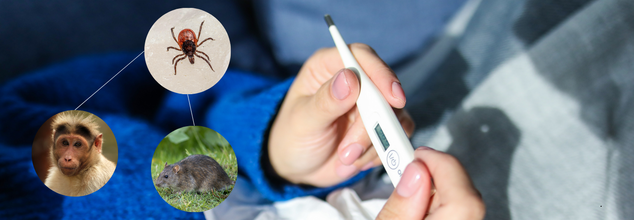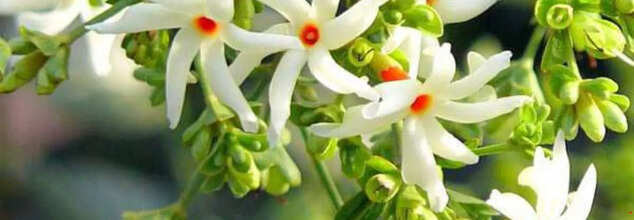
Credits: Canva
What Is The Kyasanur Forest Disease That Claimed the Life Of An 8-year-old Child In Karnataka?
Karnataka's Malenadu region, especially in the districts like Shivamogga and Chikkamagluru, saw a spike in the Kyasanur Forest Disease. With many cases, and a tragic loss of an 9-year-old child, the disease is again back in public focus.
What Is the Kyasanur Forest Disease?
Kyasanur Forest Disease or KFD is also known as the 'monkey fever'. As per the US Centers for Disease Control and Prevention (CDC), t is a viral infection that is transmitted to humans when they get bitten by infected ticks, particularly the Haemaphysalis spinigera. The disease is named after the Kuasanur Forest in Karnataka, where it was first identified in 1957.
KFD belongs to the Flaviviridae family of viruses—the same family responsible for dengue and yellow fever.
While the disease is rare, the illness is serious and is mostly confined to the regions of Karnataka, Kerala, Tamil Nadu and Goa. Animals such as monkeys and rodents are also common carriers of the virus. When these animals die from KFD, the infected ticks that drop off their bodies can bite the humans near the area. This then passes on the virus. Humans thus become the accidental hosts, however, they cannot spread the disease to others.
What Are The Symptoms And How Does The Disease Progress?
CDC notes that the incubation period, or the time between getting bitten by the infected tick and start of symptoms is usually between 3 to 8 days. The first phase lasts for about a week. The symptoms during the first phase are:
- Sudden high fever with chills
- Intense headache
- Severe muscle pain
- Vomiting, nausea, and diarrhea
- Photophobia (sensitivity to light)
- Bleeding from the nose, gums, or through vomit/stool
While many recover after this, around 10 to 20% of patients go on to the second phase of the disease. The symptoms are as followed:
- Severe headache
- Mental confusion or disorientation
- Tremors
- Vision problems
Who Are Most At Risk?
Those living or working in forest areas are most vulnerable. This includes farmers, herders, hunters, and forest department workers. Travelers visiting these areas during the dry season (November to June), when tick activity is high, are also at risk.
How Can KFD Be Prevented?
Prevention efforts are crucial in areas where KFD is known to occur. Here are some key measures:
Vaccination: A KFD vaccine is available and recommended for people in high-risk areas.
Avoiding Tick Bites: Wear long-sleeved clothing, use insect repellents with DEET, and avoid sitting on forest floors or walking through dense underbrush.
Stay Alert to Monkey Deaths: Monkey deaths in forests can signal a local outbreak. Avoid contact with dead animals.
Diagnosis, Treatment, and Recovery
There is no specific cure for KFD. Treatment involves supportive care, including:
- Managing fever and pain
- Maintaining fluid balance
- Monitoring for complications such as bleeding or neurological issues
KFD can be diagnosed through PCR tests, virus isolation, or antibody tests. With timely care, most patients recover, but the disease has a fatality rate of about 3–5%.

Credit: Canva
This Tree Revered In Hindu Texts Can Help Manage Arthritis
Prized for its soothing and calming fragrance, Parijat, fondly known as the Night Jasmine flower, is well known not only for its ornamental nature but also for its wide range of medicinal qualities. Right from treating and managing arthritis, cold and cough, fever, worms, indigestion, wounds, and diabetes, to malaria, the beautiful white bloom does it all. Parijat holds a strong place in Ayurvedic scriptures for the treatment of various diseased conditions since ancient times. According to the Indian mythological literature, Parijat is mentioned as a ‘tree from heaven’, and it is also mentioned in the Bhagwat Gita and Harivamsa Purana as the main flower that is used to worship Ma Durga. Let us know more about the curative qualities of the beautiful night jasmine flower.
Ayurvedic Benefits Of Parijat
Relieves Pain And Inflammation
Parijat intrinsically possesses potent analgesic and anti-inflammatory properties, which is pivotal in reducing joint and muscle pain, thereby reducing the chances of chronic autoimmune inflammatory diseases like rheumatoid arthritis which occurs due to the vitiation of Vata Doshas. Being a natural vasodilator, it is also used to treat painful muscle spasms, sore muscles, sciatica etc.
Grind 6 to 7 leaves of Night Jasmine and mix with water, and boil it till the quantity is reduced to half. Now, cool it and drink this concoction on an empty stomach in the morning to reduce joint pain.
Combats Respiratory Issues
Sanctified with powerful anti-inflammatory, anti-biotic, and anti-asthmatic properties, Parijat offers a one-stop traditional remedy for all sorts of respiratory distress. It is vital in treating the common cold, sore throat, cough and flu symptoms. When taken alongside honey and warm water on an empty stomach, it actively thins and loosens sputum particles within the lungs, chest and nasal cavities and eases breathing. It is also highly beneficial for providing faster relief from non-productive cough, asthma and other bronchial conditions.
Heals Wounds and Infections
Parijat portrays strong anti-bacterial, anti-viral and antifungal properties that are not only used for removing bacteria and germs from the body but also treats wounds and improves healing. The bioactive compounds present in this perfumed bloom has been used since the ancient times to treat various skin issues like sores, ulcers, skin fungus, etc.
Treats Malaria
Malaria is a mosquito-borne disease that chiefly occurs due to the malarial parasite Plasmodium characterizing symptoms like high fever, muscular pain, vomiting, convulsions etc. The potent anti-parasitic action of the parijat leaves restricts the growth of the malarial parasite right at the ring stage and hence prevents aggravation of the infection.
Promotes Digestion
Parijat is a traditional remedy for improving gut health and treating a wide range of gastrointestinal disorders like diarrhoea, flatulence, peptic ulcer, esophagitis, heartburn, gastroesophageal reflux disease, indigestion, and stomach pain. The carminative nature of the flower and the leaves helps in breaking down the food particles in the stomach and intestine, enhances the secretion of the digestive juices and thereby increases the absorption of essential nutrients through the intestines. It helps to eliminate abdominal gas and in turn reduces abdominal distension, bloating and gaseous cramps. Being a potent laxative, it also helps in free passage of stools thus treating constipation.
Regulates Diabetes
Diabetes is known as Madhumeha in Ayurveda and owing to the presence of numerous beneficial herbs, Parijat is an excellent herb for managing high sugar levels by improving the metabolism due to its Tikta (bitter) and Kashaya (astringent) properties and Kapha-Pitta balancing doshas. The excellent anti-glycemic nature of the herb plays a quintessential role in alleviating the blood sugar levels of the body. Intake of this herb activates the pancreas and stimulates the secretion of a balanced amount of Insulin and also regulates the metabolism of carbohydrates. This action readily helps the extra glucose circulating in the blood to get converted into glycogen which in turn prevents sudden spikes in the blood sugar level. It readily helps diabetic patients to maintain the control over the blood glucose levels in the blood naturally.
Manages Blood Pressure
Parijat acts as a natural antihypertensive agent which normalizes the blood pressure levels and keeps it under check. It is extremely pivotal in both hypertension and hypotension conditions. By improving the heart functions, it enhances cardiovascular endurance which brings the blood pressure to a stable level and maintains balanced readings.
Treats Piles
Piles or Haemorrhoids are enlarged blood vessels that one can get inside or around your anus (the opening of your bottom). Because of the sedentary lifestyle in today’s times, this painful condition has become one of the most common issues developed due to chronic constipation. When Vata dosha becomes imbalanced in the body, constipation is created. These conditions often lead to Piles or mass formation near or inside the opening of the anus when ignored or untreated. Parijat extensively helps to manage constipation effectively, thus preventing the formation of piles.
Augments Skin
The host of anti-bacterial properties of the Parijat leaf extract plays a crucial role in treating skin infections like acne, warts, boils, eczema, blisters, itching etc. Not only does it improve complexion by evening out the skin tone, but also clear blocked pores, and reduces various signs of ageing like wrinkles, fine lines, spots, pigmentation etc. Owing to the antiseptic nature, the oil obtained from its flowers also prevent wounds and injuries and speeds up the healing process.
Remedies Hair Troubles
The wealth of antioxidant, astringent and antimicrobial properties in Parijat flower extract makes it extremely beneficial for all sorts of hair woes. Sanctified with essential bioactive constituents, parijat not only enhances blood circulation in the hair follicles but also prevents various hair infections and actively takes part in collagen formation. It is extremely useful for treating dandruff, revitalising dull, lifeless hair. Regular use of the oil obtained from its flowers improve hair texture, adds shine and stimulates hair growth. By effectively alleviating stress, it also prevents hair fall and premature greying of hair.

Credit: Canva
Are Toothpastes Color Coded For Ingredients?
Have you ever wondered what colour coding on your toothpaste tubes indicates? Even if you haven't, there is a new claim on social media that differentiates the tubes based on coloured blocks. Multiple social media posts claim that the tiny square you see on the bottom of the tube of your toothpaste is actually part of a colour code related to the ingredients present in the product.
Here Is What The Claim States
- If there is a green square, it means the toothpaste is made from only natural ingredients.
- A blue mark means it contains a mix of natural ingredients and medication.
- A red marking means that the product contains both natural ingredients and chemical ingredients.
- And, if your toothpaste has a black square, it means it contains only chemical ingredients.
Is The Colour Coding True?
No. The colour coding is not true. One of that it does is make a distinction between 'Natural' And 'Chemical' ingredients. Experts state that all natural ingredients are made up of chemical compounds. Another issue is that it doesn't explain what "medicine" is. Is it referring to fluoride, the mineral that's often added to toothpaste to help protect against cavities? There's no way to know.
Bigger misinformation is that companies do not colour code these toothpastes because of an attempt to pull the wool over consumers' eyes. In fact, as Snopes points out, the reason for the marks has to do with how toothpaste tubes are made. The marks help light sensors detect the end of the tube, so that the machines used to prepare the tubes know where to cut or seal them.
Is There A Way To Distinguish Between
If my toothpaste tubes aren't colour coded, then how do I know which one to brush my teeth with? This is a question that may ask. The information is usually printed on the packaging, either on the tube itself or on the box it came in.
As the Indian Dental Association most of the toothpastes contain the same basic ingredients. The list includes abrasives to help clean the teeth, humectants to keep the gel or paste soft, flavouring agents and detergents to help the toothpaste foam. The IDA points out the importance of looking for a toothpaste that contains fluoride, as that ingredient helps to prevent tooth decay and cavities by strengthening the enamel.

Vaccinated And Still Worried? Truth About Measles Vaccine Safety And Effectiveness
For decades, measles was a leading causes of young children worldwide. Nearly every child would get the disease at some point, usually with serious complications, and in most sad instances, it was fatal. All of that changed overnight with the introduction of the measles vaccine in the 1960s. Since its discovery, this single medical breakthrough has rescued more than 94 million lives, the majority of whom are children, and is still among the most potent weapons in contemporary public health.
However, even with this rampant success, vaccine safety and efficacy remain concerns—particularly among parents wanting the best for their kids. If you are vaccinated but still concerned, do not worry.
How Lethal Is Measles When Not Vaccinated?
Prior to vaccine creation, measles was almost as widespread as the diseases among kids. 2 to 3 million individuals every year worldwide perished from secondary infections caused by measles. The virus is more than just an itch and fever—pneumonia, brain swelling (encephalitis), hearing impairment, and temporary immunosuppression are its possibilities. Or to put it in another way: measles convinces your immune system to lose its memory regarding what it's fighting off right now.
Actually, measles not only makes individuals ill—it destroys immune memory, compromising the body's defense system for months, even years, following the initial infection. This is particularly risky for young children whose immune systems are still maturing.
In 1954, in a school epidemic in Boston, Dr. Thomas C. Peebles and John F. Enders were able to isolate the measles virus from the blood of a student, David Edmonston. Their pioneering work resulted in the first measles vaccine, which was licensed in the United States by 1963. A variant improved further, called the Edmonston-Enders strain, has been used in the US since 1968 and is still the basis for today's MMR (Measles, Mumps, Rubella) vaccine.
In the current era, measles vaccines come as part of combination doses—either MMR or MMRV (with varicella, or chickenpox). Two-dose MMR is very effective and commonly endorsed by health organizations, such as the CDC and WHO.
How Effective Is the Measles Vaccine?
Let's get to the numbers. One dose of the MMR vaccine gives about 95% protection against measles. If a second dose is given—usually between 4 to 6 years old—protection shoots up to about 99%. That's not merely effective; that's remarkable in the realm of vaccines.
The vaccine is also 99% effective against rubella and 88% against mumps after the second dose. This is the reason why the two-dose schedule is the international norm. Indeed, measles vaccination alone is responsible for more than 60% of all childhood lives saved by vaccines worldwide over the past 50 years.
What About Side Effects of Measles Vaccine?
No medical treatment is risk-free—but risks of the measles vaccine are very low. Side effects that most frequently occur are:
- Mild fever
- Transient rash
- Soreness or redness of the skin at the site of injection
- Transitory joint stiffness (more frequently seen in adults)
Infrequently, more severe reactions such as allergic reactions (anaphylaxis) might occur, but these are very rare and are much less hazardous than the real measles virus.
Perhaps the most enduring—and most thoroughly discredited—of these myths is the spurious connection between vaccines and autism. Large international studies of millions of children have revealed no connection between the MMR vaccine and autism, developmental delay, brain damage, asthma, or diabetes. Such theories aren't merely unproven by science—science has declared them deceptive and potentially lethal.
Who Should Not Get the Measles Vaccine?
Although the MMR vaccine is safe for most people, it's not for:
- Infants younger than 6 months
- Pregnant women
- Those with severe immunocompromise
- Those with a history of known severe allergy to vaccine components
For those who cannot get vaccinated, herd immunity dependent on high vaccination rates in the community—is essential to their protection.
Do You Need a Booster Shot Later in Life?
Here's the good news: Two doses of the MMR vaccine usually provide lifelong protection. No booster is required routinely. But adults who are uncertain about their immunization status can have a blood test to assess immunity or have an extra dose as a precaution.
Should You Still Be Worried?
It's natural to have questions, particularly when it comes to the health of your loved ones. But decades of research, data, and real-world results have established:
- The measles vaccine is safe
- It is extremely effective
- It has saved more lives than any other vaccine given to children
© 2024 Bennett, Coleman & Company Limited

